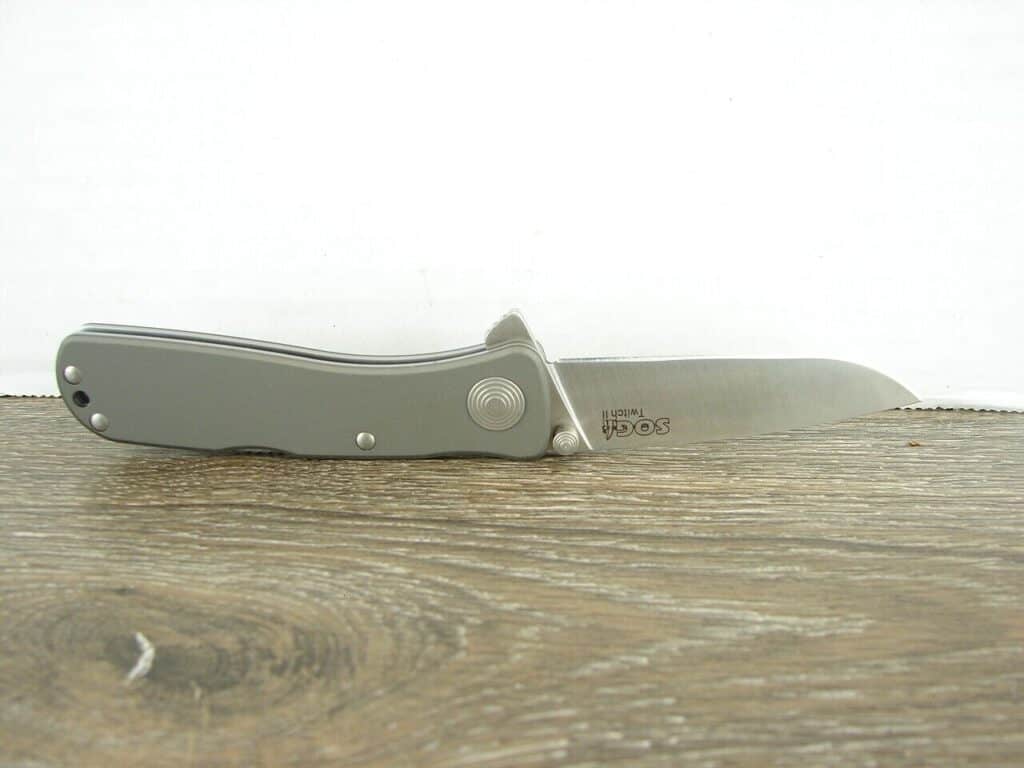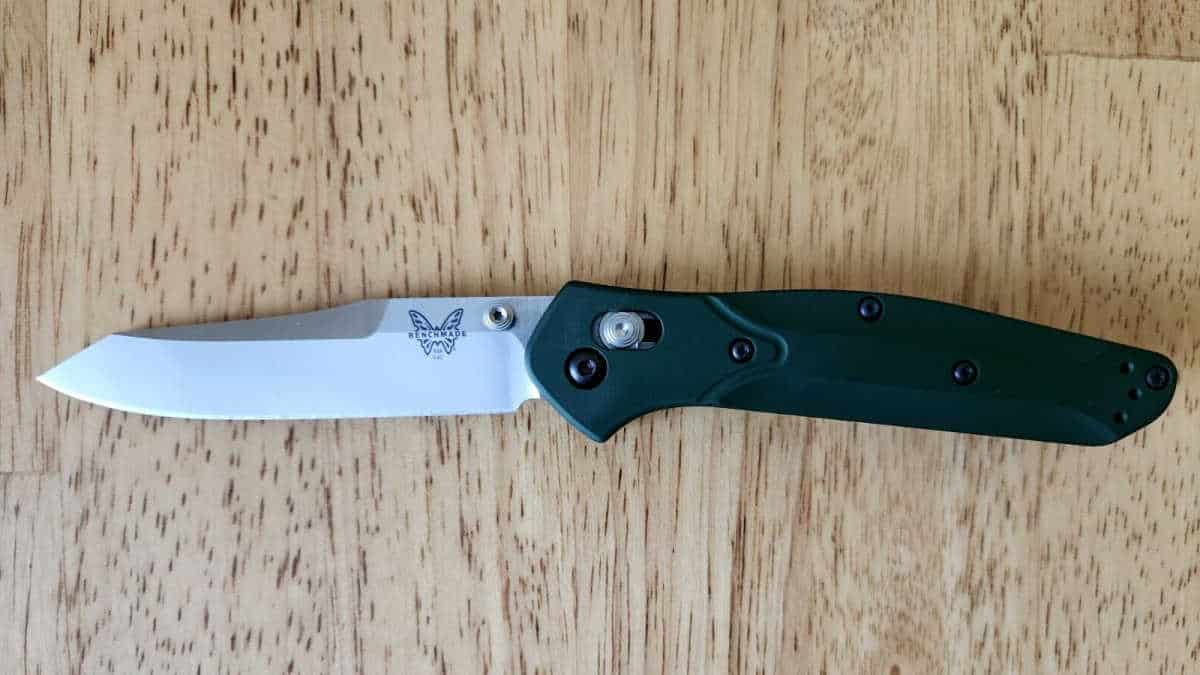As an Amazon Associate I earn from qualifying purchases.
Aluminum is a lightweight and versatile material, often used in various industries and applications. However, when it comes to knives, the question arises whether aluminum is a suitable choice for knife material. This article will discuss the advantages and disadvantages of aluminum as a knife material, considering factors such as strength, durability, and corrosion resistance.
One of the main reasons for considering aluminum in knife construction is its low density and strength. Aluminum, specifically the T6-6061 alloy, is known for its excellent tensile strength and is often used for knife handles due to its lightweight nature and durability. Additionally, aluminum can be anodized for color, hardness, and protection, making it an even more durable choice.
However, aluminum is not without its drawbacks. As a softer metal compared to other materials like stainless steel or titanium, aluminum can be more prone to chipping, denting, and scratching. While it may be a great material for knife handles, its inherent softness and inability to achieve a high hardness level make it less suitable as a blade material compared to more traditional metals such as steel.
Aluminum as a Knife Material
Properties of Aluminum
Aluminum is a lightweight, metallic material known for its corrosion resistance and ability to be anodized into various colors. Its low density makes it ideal for applications where weight is a concern, such as creating lightweight knives. Despite its lightness, aluminum’s tensile strength and durability make it a popular choice for knife handles.
Alloys and T6-6061 Alloy
When used in knives, aluminum is often combined with other elements to create alloys, which are engineered for specific properties. The most common alloy utilized in the knife industry is the T6-6061. This alloy has a high tensile strength and is typically anodized for color, hardness, and protection.
Performance and Hardness
While aluminum is not the hardest metal around, it has a sufficient level of hardness to withstand daily use in a knife handle. Alloys like T6-6061 have significant tensile strength, making them durable enough for most applications. In terms of hardness, aluminum performs at a level comparable to bronze.
Corrosion Resistance
A major advantage of aluminum as a knife material is its superior corrosion resistance. Unlike some steels and metals that can suffer from rust, aluminum is naturally resistant to oxidation. Anodization also adds a layer of protection to further enhance its corrosion resistance.
Strength-to-Weight Ratio
One of the standout qualities of aluminum is its impressive strength-to-weight ratio. The lightweight nature of aluminum allows for a comfortable, easy-to-handle knife, while not compromising on durability and strength. This makes aluminum an attractive option for knife enthusiasts who value both performance and ease of use.
Comparison with Other Knife Handle Materials
Stainless Steel Handles
Stainless steel handles are a popular choice for knives due to their corrosion resistance and strength. They provide a good balance between durability and aesthetics, making them suitable for both utility and decorative knives. However, stainless steel handles can be slippery when wet, which might not be ideal for some users. Additionally, they can be heavier than other materials, adding some extra weight to the knife.
Titanium Handles
Titanium handles are lightweight, strong, and highly durable. They are more robust than aluminum but also slightly heavier. Titanium is corrosion-resistant and can be anodized or bead-blasted for improved aesthetics. While more expensive to machine, titanium handles offer a balance between strength, weight, and style.
Synthetic Handles
Synthetic knife handle materials, such as G-10, carbon fiber, and Micarta, are known for their durability and low maintenance requirements. G-10, for example, is a fiberglass-based laminate known for its moisture resistance and strength. Carbon fiber is a lightweight material that provides excellent structural strength. Micarta is a composite made from various fibers and resins, offering a non-slippery surface and a unique look. However, some may find synthetic materials to lack the natural warmth of wooden or natural material handles.
Wooden Handles
Wooden handles are a classic choice, providing a comfortable grip and appealing aesthetics. Hardwood handles are durable and add a sense of craftsmanship to the knife. However, wood can be more susceptible to damage from moisture and may require regular maintenance, such as oiling, to keep it in good condition. Wooden handles can also be more prone to wear and tear compared to metal or synthetic handles.
Natural Material Handles
Natural knife handle materials, like bone and leather, offer a unique, traditional look and comfortable feel. However, these materials may not be as durable as metal or synthetic options, and they might require extra care and maintenance to keep them in good condition. Natural materials are also sensitive to temperature and humidity changes, which can affect their performance and longevity.
Popular Aluminum Handled Knives
Aluminum is a popular material for knife handles due to its durability, lightweight nature, and corrosion resistance. In addition, it can be anodized into various colors, adding a personal touch to your knife. Several popular knife models feature aluminum handles, and we will discuss some of them in this section.
The Kershaw Leek is a well-known folding knife with a smooth anodized aluminum handle. Its slim design and lightweight attributes make it user-friendly and perfect for everyday carry. The Leek also boasts a sharp blade made from high-quality steel, ensuring efficient cutting abilities.
Another popular aluminum-handled knife is the Spyderco Dragonfly. This compact and lightweight folding knife features an anodized aluminum handle, providing both durability and style. The Dragonfly’s refined ergonomic design, combined with its excellent blade steel, make it an ideal choice for various cutting tasks.
The Benchmade 940 is renowned for its exceptional performance and high-quality materials. Its aluminum handle gives the knife a solid grip, ensuring that it stays in the user’s hand even during the most demanding tasks. With its reliable and swift AXIS lock mechanism, the Benchmade 940 is perfect for those who appreciate efficiency and style.

Another noteworthy aluminum-handled knife is the SOG Twitch II. This sleek folding knife features assisted opening technology and a sturdy handle made from anodized aluminum. The SOG Twitch II not only offers smooth operation but also exceptional durability, making it perfect for daily use.
Lastly, the Buck Nobleman is a stylish yet utilitarian folding knife decked with an anodized aluminum handle. Its durable construction and reliable blade steel make it a dependable tool for various cutting tasks.
In conclusion, aluminum handles have become increasingly popular in the knife industry, and the models mentioned above showcase the material’s benefits. Users can enjoy a lightweight, corrosion-resistant, and stylish option by choosing an aluminum-handled knife for their cutting needs.
Pros and Cons of Aluminum Handles
Aluminum is a popular material for knife handles due to its many advantages. However, it’s essential to understand both the pros and cons before deciding if it’s the right choice for you.
Pros:
- Durability: Aluminum is known for its strength and durability, making it a reliable choice for knife handles. It has a long lifespan and is resistant to corrosion, ensuring your knife will withstand the test of time1.
- Lightweight: One of the significant benefits of aluminum handles is their lightweight nature2. This can make using the knife more comfortable, particularly for extended periods.
- Appearance: With options to anodize the material, aluminum knife handles offer a range of aesthetically pleasing finishes3. Even when uncoated, a polished aluminum handle has a clean, professional appearance easily maintained with regular care4.
- Waterproof and low maintenance: Aluminum is naturally water resistant, which is a great advantage when it comes to maintenance3. Furthermore, this material does not require extensive care to keep its appearance and function.
Cons:
- Grip and slipperiness: Although aluminum handle knives are often designed with texture or grooves for better grip, the material itself can be slippery when wet5. This could pose a safety risk, particularly when cutting through tough materials or using the knife in damp environments.
- Scratches and dings: Aluminum is susceptible to scratches, dents, and dings, which may impact its overall appearance1. While the material may remain functional, these blemishes could be bothersome to those who prefer pristine-looking tools.
- Value: Depending on the type of aluminum and the anodization process, aluminum-handled knives can sometimes be pricier than other options5. However, this is often balanced out by the durability and long-lasting nature of the material.
In summary, aluminum knife handles offer durability, lightweightness, and low-maintenance benefits. However, they do have some drawbacks, such as being susceptible to scratches and dings and potentially slippery in the hand. Knowing these pros and cons will help you make an informed decision on whether aluminum is the right choice for your knife handle.
Conclusions and Recommendations
In comparison to other materials like steel, plastic, and titanium, aluminum as a knife material offers several unique advantages and disadvantages.
One of the key strengths of aluminum is that it is lightweight, which makes it an excellent choice for a knife handle material. This property allows for better balance and ease of use, particularly in everyday carry (EDC) knives.
Furthermore, aluminum is corrosion-resistant, which is an essential factor in the maintenance and lifespan of a knife. This material is durable and can withstand various environmental conditions, effectively preventing rust and other harmful chemical reactions.
However, there are some drawbacks to using aluminum in knives. While the material is durable, it is not as hard as steel or titanium, which makes it less suitable as a blade material. Additionally, aluminum is prone to scratches, dents, and dings due to its softer nature compared to other metals, such as stainless steel.
Despite these disadvantages, aluminum remains a popular option for knife handles because of its style and versatility. It can be anodized into different colors and patterns, allowing for a more unique and personalized touch in your knife choice.
In summary, aluminum is best suited as a handle material and offers significant benefits, including its lightweight nature, corrosion resistance, and customizable appearance. However, its susceptibility to cosmetic damage and lack of hardness make it less appropriate as a blade material. For optimal knife performance and durability, consider pairing an aluminum handle with a high-quality stainless steel or titanium blade.
Do Sheepsfoot Blades Have A Purpose? (Cuz They’re Ugly…)
Spetsnaz Machetes – Blades Of The Russian Special Forces
What Is The Actual Purpose Of A Spear Point Knife Blade?
CRKT CEO Review – Coolest, Most Worthless Knife Ever?
How Sharp Is A Scalpel? (Is It Sharper Than A Razor?)
Can You Shave With A Knife? (Yes, Here’s How)
As an Amazon Associate I earn from qualifying purchases.







